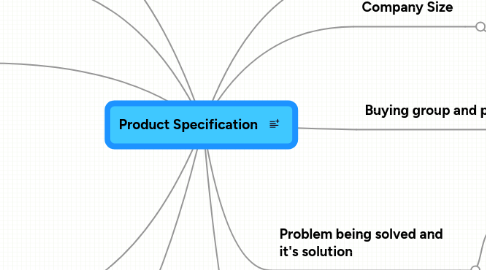
1. Barriers to Adoption
1.1. Technical or practical barriers that eliminate some part of the market. It may be a deliberate ROI justification.
1.1.1. Technical (e.g., Windows only)
1.1.2. Language (e.g., English only)
1.2. Are we planning to remove these barriers over time?
1.3. Artificial barriers are created to control supply and demands on production
1.3.1. e.g, roll out in US first
1.3.2. Only top 5 euro countries
1.3.3. Only to Tier 1 ISPs initially
2. Topic and Content
2.1. What is the product about? What content is in there?
2.2. What countries is the product interested in?
3. Product components
3.1. What are the specific deliverables that the client will get to use? What is the value proposition and usage scenarios for each component?
4. Go-to-Market
4.1. Sales channels
4.1.1. Account reps
4.1.2. Consultants
4.1.3. Web interface
4.2. Marketing
4.2.1. Targeted campaigns
4.2.2. Processs for persoanlizing the targeting campaign
4.3. Promotion
4.3.1. Advertising
4.3.2. Special offers
4.3.3. Event sponsorship
4.4. Bundling
4.4.1. Product
4.4.2. Existing customer offers
5. Production
5.1. Are there any limits on production (unscalability)?
5.2. How are we going to produce?
5.3. What quality level are we aiming at?
6. Customer Segment (e.g., NAICS)
6.1. What industry group is the company purchasing. It can be multiple groups, but then there are multiple value propositions, and each one of these would be a new map.
7. Company Size
7.1. Within each group, we need to be clear on the size of company. An SMB will have a different value calculation and ability to pay, and may therefore need a new business model.
8. Buying group and profile
8.1. Within the company, who is doing to make the purchase decision? Who is going to pay? Are they the same as the beneficiary? What internal processes are likely to be found?
8.1.1. Personal value: what's in it for the individual buyer? e.g., if just a buyer, will you make it easy for the buyer to make the purchase and justify it
8.1.2. Corporate value: will it be easy to see the ROI, and enable the buyer to justify the ROI to others
8.1.3. Will the buyer be able to find budget from a recognized source, or will this be a budget that will have to be invented? if invented, will the buyer have that sort of authority?
9. Problem being solved and it's solution
9.1. What end user problem is being solved, and how much of a fix for the problem is this. This gives the VALUE of the solution in the customers' eyes.
9.2. To what extent does the solution solve the problem.
9.2.1. CITP -> 100%
9.2.2. Helpful -> 30%
9.2.3. Informative -> 10%
10. Price/investment, ASP
10.1. What price is being sought after? It's helpful to have this idea up front as it tempers almost all other decisions. The price has to be less than or equal to the value, in as much as it's calculable.
10.1.1. MAX PRICE = {(Value of solution to client) X (Percent of the solution that the product provides) * (Scalar ~50%)} - {cost to client of implementation, sales process}
10.1.1.1. Note: Scalar is a factor that reduces the price someone will pay to solve a problem. e.g, noone will pay €100,000 to solve a €100k problem. They migth as well do nothing.
10.1.1.2. Note: if implementation costs exceed the first half of the equation, the market has flopped.
